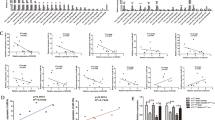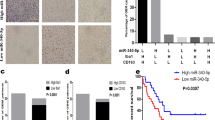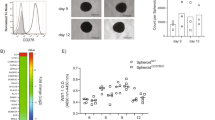Abstract
Metastasis of solid tumors is associated with poor prognosis and bleak survival rates. Tumor-infiltrating myeloid cells (TIMs) are known to promote metastasis, but the mechanisms underlying their collaboration with tumor cells remain unknown. Here, we report an oncogenic role for microRNA (miR) in driving M2 reprogramming in TIMs, characterized by the acquisition of pro-tumor and pro-angiogenic properties. The expression of miR-21, miR-29a, miR-142-3p and miR-223 increased in myeloid cells during tumor progression in mouse models of breast cancer and melanoma metastasis. Further, we show that these miRs are regulated by the CSF1-ETS2 pathway in macrophages. A loss-of-function approach utilizing selective depletion of the miR-processing enzyme Dicer in mature myeloid cells blocks angiogenesis and metastatic tumor growth. Ectopic expression of miR-21 and miR-29a promotes angiogenesis and tumor cell proliferation through the downregulation of anti-angiogenic genes such as Col4a2, Spry1 and Timp3, whereas knockdown of the miRs impedes these processes. miR-21 and miR-29a are expressed in Csf1r+ myeloid cells associated with human metastatic breast cancer, and levels of these miRs in CD115+ non-classical monocytes correlates with metastatic tumor burden in patients. Taken together, our results suggest that miR-21 and miR-29a are essential for the pro-tumor functions of myeloid cells and the CSF1-ETS2 pathway upstream of the miRs serves as an attractive therapeutic target for the inhibition of M2 remodeling of macrophages during malignancy. In addition, miR-21 and miR-29a in circulating myeloid cells may potentially serve as biomarkers to measure therapeutic efficacy of targeted therapies for CSF1 signaling.
This is a preview of subscription content, access via your institution
Access options
Subscribe to this journal
Receive 50 print issues and online access
$259.00 per year
only $5.18 per issue
Buy this article
- Purchase on Springer Link
- Instant access to full article PDF
Prices may be subject to local taxes which are calculated during checkout







Similar content being viewed by others
References
Bröcker EB, Zwadlo G, Suter L, Brune M, Sorg C . Infiltration of primary and metastatic melanomas with macrophages of the 25F9-positive phenotype. Cancer Immunol Immunother 1987; 25: 81–86.
Leek RD, Harris AL . Tumor-associated macrophages in breast cancer. J Mammary Gland Biol Neoplasia 2002; 7: 177–189.
Jensen TO, Schmidt H, Møller HJ, Høyer M, Maniecki MB, Sjoegren P et al. Macrophage markers in serum and tumor have prognostic impact in American Joint Committee on Cancer stage I/II melanoma. J Clin Oncol 2009; 27: 3330–3337.
Qian BZ, Pollard JW . Macrophage diversity enhances tumor progression and metastasis. Cell 2010; 141: 39–51.
Chen Q, Zhang XH, Massague J . Macrophage binding to receptor VCAM-1 transmits survival signals in breast cancer cells that invade the lungs. Cancer Cell 2011; 20: 538–549.
Qian B, Deng Y, Im JH, Muschel RJ, Zou Y, Li J et al. A distinct macrophage population mediates metastatic breast cancer cell extravasation, establishment and growth. PLoS One 2009; 4: e6562.
Qian BZ, Li J, Zhang H, Kitamura T, Zhang J, Campion LR et al. CCL2 recruits inflammatory monocytes to facilitate breast-tumour metastasis. Nature 2011; 475: 222–225.
Yan HH, Pickup M, Pang Y, Gorska AE, Li Z, Chytil A et al. Gr-1+CD11b+ myeloid cells tip the balance of immune protection to tumor promotion in the premetastatic lung. Cancer Res 2010; 70: 6139–6149.
Wang T, Ge Y, Xiao M, Lopez-Coral A, Azuma R, Somasundaram R et al. Melanoma-derived conditioned media efficiently induce the differentiation of monocytes to macrophages that display a highly invasive gene signature. Pigment Cell Melanoma Res 2012; 4: 493–505.
Chen P, Huang Y, Bong R, Ding Y, Song N, Wang X et al. Tumor-associated macrophages promote angiogenesis and melanoma growth via adrenomedullin in a paracrine and autocrine manner. Clin Cancer Res 2011; 17: 7230–7239.
Zaidi MR, Davis S, Noonan FP, Graff-Cherry C, Hawley TS, Walker RL et al. Interferon-γ links ultraviolet radiation to melanomagenesis in mice. Nature 2011; 469: 548–553.
Esquela-Kerscher A, Slack FJ . Oncomirs—microRNAs with a role in cancer. Nat Rev Cancer 2006; 6: 259–269.
O'Connell RM, Rao DS, Chaudhuri AA, Baltimore D . Physiological and pathological roles for microRNAs in the immune system. Nat Rev Immunol 2010; 10: 111–122.
Liu G, Abraham E . MicroRNAs in immune response and macrophage polarization. Arterioscler Thromb Vasc Biol 2013; 33: 170–177.
Squadrito ML, Pucci F, Magri L, Moi D, Gilfillan GD, Ranghetti A et al. miR-511-3p modulates genetic programs of tumor-associated macrophages. Cell Rep 2012; 1: 141–154.
Zonari E, Pucci F, Saini M, Mazzieri R, Politi LS, Gentner B et al. A role for miR-155 in enabling tumor-infiltrating innate immune cells to mount effective anti-tumor responses. Blood 2013; 122: 243–252.
Zabuawala T, Taffany DA, Sharma SM, Merchant A, Adair B, Srinivasan R et al. An ets2-driven transcriptional program in tumor-associated macrophages promotes tumor metastasis. Cancer Res 2010; 70: 1323–1333.
Fowles LF, Martin ML, Nelsen L, Stacey KJ, Redd D, Clark YM et al. Persistent activation of mitogen-activated protein kinases p42 and p44 and ets-2 phosphorylation in response to colony-stimulating factor 1/c-fms signaling. Mol Cell Biol 1998; 18: 5148–5156.
Conway JG, McDonald B, Parham J, Keith B, Rusnak DW, Shaw E et al. Inhibition of colony-stimulating-factor-1 signaling in vivo with the orally bioavailable cFMS kinase inhibitor GW2580. Proc Natl Acad Sci USA 2005; 102: 16078–16083.
Clausen BE, Burkhardt C, Reith W, Renkawitz R, Forster I . Conditional gene targeting in macrophages and granulocytes using LysMcre mice. Transgenic Res 1999; 8: 265–277.
Rae F, Woods K, Sasmono T, Campanale N, Taylor D, Ovchinnikov DA et al. Characterisation and trophic functions of murine embryonic macrophages based upon the use of a Csf1r-EGFP transgene reporter. Dev Biol 2007; 308: 232–246.
Tagliani E, Shi C, Nancy P, Tay CS, Pamer EG, Erlebacher A . Coordinate regulation of tissue macrophage and dendritic cell population dynamics by CSF-1. J Exp Med 2011; 208: 1901–1916.
Mossadegh-Keller N, Sarrazin S, Kandalla PK, Espinosa L, Stanley ER, Nutt S et al. M-CSF instructs myeloid lineage fate in single haematopoietic stem cells. Nature 2013; 497: 239–243.
Yan LX, Huang XF, Shao Q, Huang MY, Deng L, Wu QL et al. MicroRNA miR-21 overexpression in human breast cancer is associated with advanced clinical stage, lymph node metastasis and patient poor prognosis. RNA 2008; 14: 2348–2360.
Gebeshuber CA, Zatloukal K, Martinez J . miR-29a suppresses tristetraprolin, which is a regulator of epithelial polarity and metastasis. EMBO Rep 2009; 10: 400–405.
Gao D, Mittal V . The role of bone-marrow-derived cells in tumor growth, metastasis initiation and progression. Trends Mol Med 2009; 15: 333–343.
Gabrilovich DI, Ostrand-Rosenberg S, Bronte V . Coordinated regulation of myeloid cells by tumours. Nat Rev Immunol 2012; 22: 253–268.
Strauss-Ayali D, Conrad SM, Mosser DM . Monocyte subpopulations and their differentiation patterns during infection. J Leukoc Biol 2007; 82: 244–252.
Sica A, Bronte V . Altered macrophage differentiation and immune dysfunction in tumor development. J Clin Invest 2007; 117: 1155–1166.
De Palma M, Venneri MA, Galli R, Sergi Sergi L, Politi LS, Sampaolesi M et al. Tie2 identifies a hematopoietic lineage of proangiogenic monocytes required for tumor vessel formation and a mesenchymal population of pericyte progenitors. Cancer Cell 2005; 8: 211–226.
Lu TX, Hartner J, Lim EJ, Fabry V, Mingler MK, Cole ET et al. MicroRNA-21 limits in vivo immune response-mediated activation of the IL-12/IFN-gamma pathway, Th1 polarization, and the severity of delayed-type hypersensitivity. J Immunol 2011; 187: 3362–3373.
Ma F, Xu S, Liu X, Zhang Q, Xu X, Liu M et al. The microRNA miR-29 controls innate and adaptive immune responses to intracellular bacterial infection by targeting interferon-gamma. Nat Immunol 2011; 12: 861–869.
Sheedy FJ, Palsson-McDermott E, Hennessy EJ, Martin C, O'Leary JJ, Ruan Q et al. Negative regulation of TLR4 via targeting of the proinflammatory tumor suppressor PDCD4 by the microRNA miR-21. Nat Immunol 2010; 11: 141–147.
Sica A, Mantovani A . Macrophage plasticity and polarization: in vivo veritas. J Clin Invest 2012; 122: 787–795.
Brain O, Owens BM, Pichulik T, Allan P, Khatamzas E, Leslie A et al. The intracellular sensor NOD2 induces microRNA-29 expression in human dendritic cells to limit IL-23 release. Immunity 2013; 39: 521–536.
Qi JH, Ebrahem Q, Moore N, Murphy G, Claesson-Welsh L, Bond M et al. A novel function for tissue inhibitor of metalloproteinases-3 (TIMP3): inhibition of angiogenesis by blockage of VEGF binding to VEGF receptor-2. Nat Med 2003; 9: 407–415.
Gabriely G, Wurdinger T, Kesari S, Esau CC, Burchard J, Linsley PS et al. MicroRNA 21 promotes glioma invasion by targeting matrix metalloproteinase regulators. Mol Cell Biol 2008; 28: 5369–5380.
Marneros AG, Olsen BR . The role of collagen-derived proteolytic fragments in angiogenesis. Matrix Biol 2001; 20: 337–345.
Lamagna C, Aurrand-Lions M, Imhof BA . Dual role of macrophages in tumor growth and angiogenesis. J Leukoc Biol 2006; 80: 705–713.
Cho HJ, Jung JI, Lim do Y, Kwon GT, Her S, Park JH et al. Bone marrow-derived, alternatively activated macrophages enhance solid tumor growth and lung metastasis of mammary carcinoma cells in a Balb/C mouse orthotopic model. Breast Cancer Res 2012; 14: R81.
Fabbri M, Paone A, Calore F, Galli R, Gaudio E, Santhanam R et al. MicroRNAs bind to Toll-like receptors to induce prometastatic inflammatory response. Proc Natl Acad Sci USA 2012; 109: E2110–E2116.
Yang M, Chen J, Su F, Yu B, Su F, Lin L et al. Microvesicles secreted by macrophages shuttle invasion-potentiating microRNAs into breast cancer cells. Mol Cancer 2011; 10: 117.
Si ML, Zhu S, Wu H, Lu Z, Wu F, Mo YY . miR-21-mediated tumor growth. Oncogene 2007; 26: 2799–2803.
Croce CM . Causes and consequences of microRNA dysregulation in cancer. Nat Rev Genet 2009; 10: 704–714.
Chou J, Lin JH, Brenot A, Kim JW, Provot S, Werb Z . GATA3 suppresses metastasis and modulates the tumour microenvironment by regulating microRNA-29b expression. Nat Cell Biol 2013; 15: 201–213.
Kumar MS, Pester RE, Chen CY, Lane K, Chin C, Lu J et al. Dicer1 functions as a haploinsufficient tumor suppressor. Genes Dev 2009; 23: 2700–2704.
DeNardo DG, Brennan DJ, Rexhepaj E, Ruffell B, Shiao SL, Madden SF et al. Leukocyte complexity predicts breast cancer survival and functionally regulates response to chemotherapy. Cancer Discov 2011; 1: 54–67.
Priceman SJ, Sung JL, Shaposhnik Z, Burton JB, Torres-Collado AX, Moughon DL et al. Targeting distinct tumor-infiltrating myeloid cells by inhibiting CSF-1 receptor: combating tumor evasion of antiangiogenic therapy. Blood 2010; 115: 1461–1471.
Pyonteck SM, Akkari L, Schuhmacher AJ, Bowman RL, Sevenich L, Quail DF et al. CSF-1R inhibition alters macrophage polarization and blocks glioma progression. Nat Med 2013; 19: 1264–1272.
Mok S, Koya RC, Tsui C, Xu J, Robert L, Wu L et al. Inhibition of CSF1 receptor improves the anti-tumor efficacy of adoptive cell transfer immunotherapy. Cancer Res 2014; 74: 153–161.
Wei G, Guo J, Doseff AI, Kusewitt DF, Man AK, Oshima RG et al. Activated Ets2 is required for persistent inflammatory responses in the motheaten viable model. J Immunol 2004; 173: 1374–1379.
Yamamoto H, Flannery ML, Kupriyanov S, Pearce J, McKercher SR, Henkel GW et al. Defective trophoblast function in mice with a targeted mutation of Ets2. Genes Dev 1998; 12: 1315–1326.
Pei XF, Noble MS, Davoli MA, Rosfjord E, Tilli MT, Furth PA et al. Explant-cell culture of primary mammary tumors from MMTV-c-Myc transgenic mice. In Vitro Cell Dev Biol Anim 2004; 40: 14–21.
Dunham LJ, Stewart HL . A survey of transplantable and transmissible animal tumors. J Nat Cancer Inst 1953; 13: 1299–1377.
Fidler IJ . Biological behavior of malignant melanoma cells correlated to their survival in vivo. Cancer Res 1975; 35: 218–224.
Schindelin J, Arganda-Carreras I, Frise E, Kaynig V, Longair M, Pietzsch T et al. Fiji: an open-source platform for biological-image analysis. Nat Methods 2012; 9: 676–682.
Hu R, Sharma SM, Bronisz A, Srinivasan R, Sankar U, Ostrowski MC . Eos, MITF, and PU.1 recruit corepressors to osteoclast-specific genes in committed myeloid progenitors. Mol Cell Biol 2007; 27: 4018–4027.
Livak KJ, Schmittgen TD . Analysis of relative gene expression data using real-time quantitative PCR and the 2(-Delta Delta C(T)) Method. Methods 2001; 25: 402–408.
Acknowledgements
We thank Yongqi Wu for help with flow cytometry. We also wish to acknowledge the histology core, OSU Comprehensive Cancer Center Microarray, Nucleic Acids, Analytical Cytometry, Microscopy and Biostatistics Core Shared Resources for technical assistance. This work was funded through National Institutes of Health grants (NIHPO1CA097189 and RO1CA053271) and the Evelyn Simmers Foundation to MCO.
Author information
Authors and Affiliations
Corresponding author
Ethics declarations
Competing interests
The authors declare no conflict of interest.
Additional information
Supplementary Information accompanies this paper on the Oncogene website
Rights and permissions
About this article
Cite this article
Mathsyaraja, H., Thies, K., Taffany, D. et al. CSF1-ETS2-induced microRNA in myeloid cells promote metastatic tumor growth. Oncogene 34, 3651–3661 (2015). https://doi.org/10.1038/onc.2014.294
Received:
Revised:
Accepted:
Published:
Issue Date:
DOI: https://doi.org/10.1038/onc.2014.294
This article is cited by
-
New insights into epigenetic regulation of resistance to PD-1/PD-L1 blockade cancer immunotherapy: mechanisms and therapeutic opportunities
Experimental Hematology & Oncology (2022)
-
Dicer deficiency impairs proliferation but potentiates anti-tumoral effect of macrophages in glioblastoma
Oncogene (2022)
-
VSSP abrogates murine ovarian tumor-associated myeloid cell-driven immune suppression and induces M1 polarization in tumor-associated macrophages from ovarian cancer patients
Cancer Immunology, Immunotherapy (2022)
-
Regulation of breast cancer metastasis signaling by miRNAs
Cancer and Metastasis Reviews (2020)
-
MicroRNA expression patterns in canine mammary cancer show significant differences between metastatic and non-metastatic tumours
BMC Cancer (2017)



